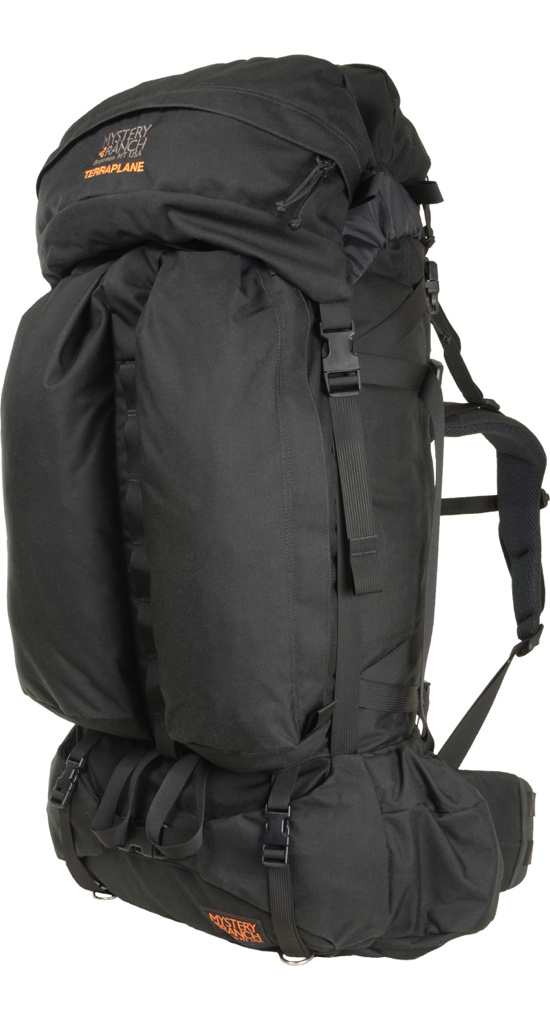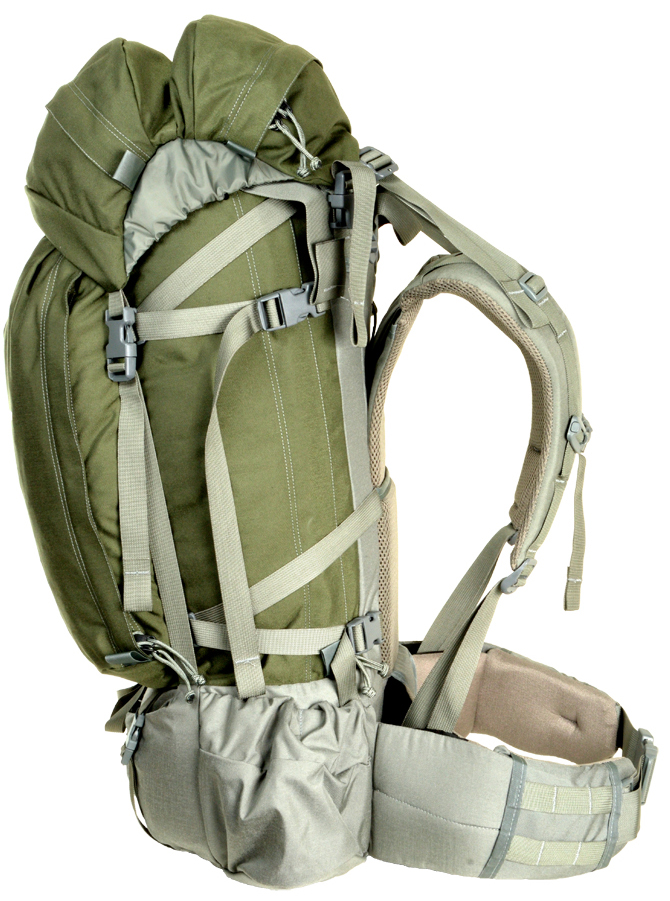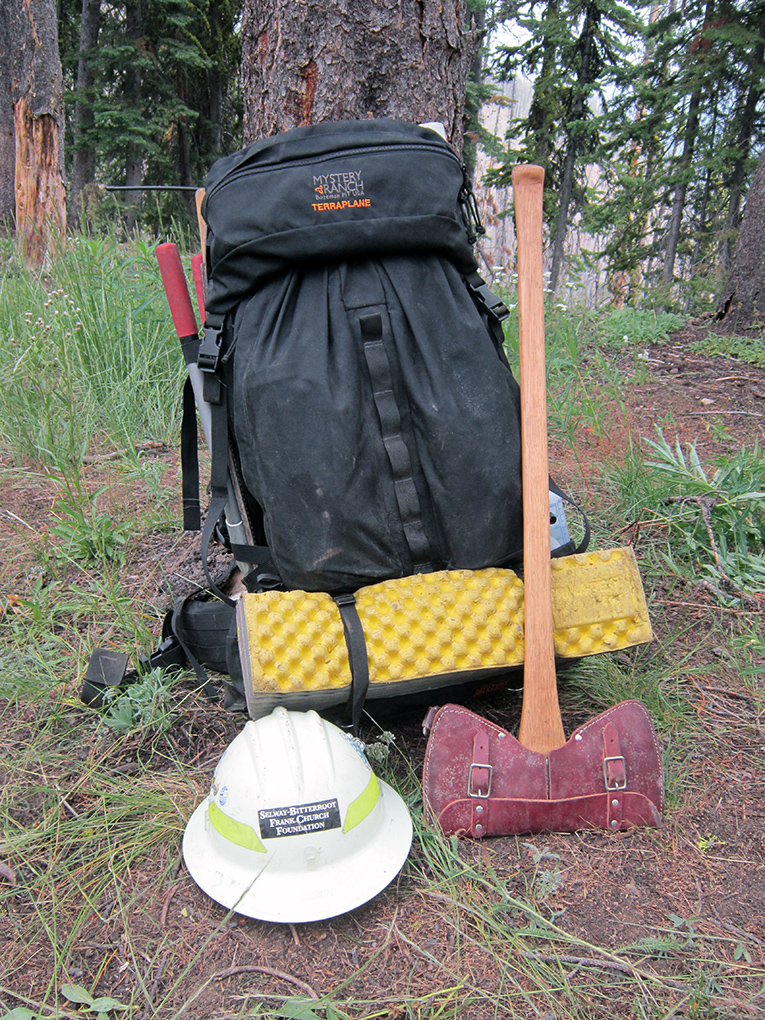
Mystery Ranch Terraplane
Specs:
- Volume: 82 liters; 5000 cubic inches
- Stated Weight: 7 lbs 7 oz; 3.37kg
- Stated Dimensions: 28 x 12 x 9.5”
Features:
- Guide Frame and Futura Yoke
- Contour Lumbar Wrap
- Daypack Lid with Waistbelt Strap
- Back Long Pockets
- Speed Zip Sleeping Bag Compartment
- Side Zip Access
- Water Bottle Pockets
- Hydration Reservoir Compatible
- Hauls 50 to 100 pound loads
Construction:
- Main Pack Fabric: 500 dernier Cordura (DWR treated and polyurethane coated)
- Bottom Fabric: Double layer of 500 dernier Cordura (DWR treated and polyurethane coated)
- Shroud Fabric: 200 dernier Nylon (DWR treated and polyurethane coated)
- Frame: Two ¼” fiberglass stays
- Framesheet: .060 HDPE
Reviewer Info:
- Height: 5’10”
- Weight: 165 lbs
- Torso Length: 21” (Iliac crest to C7 invertebrate)
- Waist: 30-32”
Color: Black
MSRP: $485
Days Tested: 10
Locations Tested: Frank Church-River of No Return Wilderness, Idaho
For the last seven years, I have worked as a Wilderness Ranger in Idaho’s Frank Church-River of No Return Wilderness, a job that does not treat backpacks kindly. In addition to carrying everything necessary for a ten-day, self-supported trip, my pack must also accommodate five-foot cross-cut saws, axes, sledge hammers and random bits of trash.
I have used a number of different packs over the years (Arc’teryx Bora 80, Osprey Aether 65, to name a few), and I have destroyed each one within a few seasons. Dana Gleason, founder of Dana Design, started Mystery Ranch in 2000 with one design philosophy in mind: to “make exceptionally comfortable, incredibly durable packs for people who depend on their gear.”
The Terraplane had been one of Dana Design’s most popular packs for years, and Mystery Ranch still offers the Terraplane, with some minor tweaks to the original models. Given the company and pack’s impressive reputation, I was curious to see whether the Terraplane could truly withstand the rigors of a ranger’s work.
Fit
While Mystery Ranch offers only one frame size for their packs, they provide a wide range of waistbelt and yoke sizes. In order to achieve the most precise fit, Mystery Ranch has a lot of information on their website about how to select the appropriate size, and they will also build custom parts too, if necessary. If you can’t make it to the Mystery Ranch headquarters in Bozeman to have their staff personally fit your pack (a trip definitely worth taking if convenient), all packs come with detailed, easy instructions that explain how to adjust the pack for the ideal fit.
At 5’10” with a 30-32” waist, I generally wear a men’s Medium in pretty much everything. The Medium yoke (for men 5’9”- 6’4” and women over 5’11”) and Small waist belt (said to fit 29-34” waists) both fit me very well.
Guide Frame and Suspension
As a Wilderness Ranger, I pretty much always have to carry heavy loads, and a pack with a good suspension system can make the experience much more comfortable. After carrying the Terraplane with loads up to 90 pounds, I found the pack’s frame and suspension really impressive.
Mystery Ranch calls their heavy duty internal framing system on the Terraplane the Guide Frame, built to handle loads up to 100 pounds for extended periods of time. The Guide Frame is composed of two independent frames, one for the load and the other for shaping, which are linked through tensioning.

The main frame is supported by two 1/4” fiberglass stays backed by a full length .060 HDPE frame sheet. In order to maximize load transfer, this straight, layered construction creates a stiff vertical structure to sit in line with your back. Compared to other packs that use steel or aluminum stays, like some of Gregory’s frames, Mystery Ranch’s fiberglass stays are more compliant, but laterally-stiffer, which I found increased comfort on long days.
The pack’s second frame, or the Futura Yoke, is a composite sheet built to work with the shape of your back once it is adjusted. Mystery Ranch describes the Futura Yoke as a “Velcro anchored telescoping shoulder pad system.” The yoke’s Velcro backing allows for an extremely wide range of adjustability, since I could make tiny incremental adjustments, rather than simply working with set points of adjustment that many packs have. The precise fit I attained with the yoke, in conjunction with the main frame, made the Guide Frame system superior to and more comfortable than the fit of any other pack I’ve used.
Packing the Terraplane; Pockets / Storage
With an 82-liter capacity, the Terraplane has enough room to carry a very large amount of gear. The Terraplane is not a fast and light pack for weekend trips or thru-hikes where there are relatively shorter stretches between re-supplies. Instead, it is better suited for longer expeditions.
With all of the food, gear, and tools for my 10-day self supported trips, I need a pack that is at least 80 liters. Because I try limit the pieces of gear hanging off the outside of my pack, plenty of interior storage space is crucial. Beside my tools and sleeping pad, I was able to fit all of my other gear inside the Terraplane, between the main compartment and the several other small pockets.

In the main compartment, I had plenty of room to pack my tent, bear canister with food, and sleeping bag, keeping the heavier, larger items low and close to my back. The Terraplane has a “Speed-zip” compartment at the bottom of the pack, which can be accessed by a zipper. While this section of the pack is not separated from the main compartment, there is an internal sling that can be clipped across the interior to create a separate compartment. Even though Mystery Ranch designates this pocket for sleeping bags, my Go-Lite Shangri-La 3 tent fits in easily too.
Next, I stuffed my extra layers and socks into the remaining cracks between the larger items. Finally, there was still enough room left in the main compartment for my Jetboil, first aid kit, gaiters and rain jacket – all pieces that I like to leave within easy access. The Terraplane also has zipper that runs along the side of the main compartment, making it easy to access gear toward the middle or bottom of the pack.
The Terraplane has two long, parallel pockets on the front of the pack, which were perfect for holding smaller items, such as paperwork, a book, toiletries, an axe stone, or a multi-tool. Even though I have put a number of items in each of them, I haven’t come close to reaching their full capacity. I leave most other things that I need to access frequently (my map, compass, radio, camera, GPS, water drops, and spare 2L soft bottles) in the Terraplane’s removable top lid, or “brain.”
The Terraplane’s brain also can be easily un-clipped from its four buckles and converted into a fanny pack, which is perfect for shorter day hikes and scrambles. Although the brain lacks the structure to really be comfortable for extended trips, its two pockets had more than enough room to fit the essentials for quick day trips, such as my fly box, leader and tippet, water bottle, rain jacket, can of beer, sandwich and orange. And when the brain is not being used as a fanny pack, its waistbelt remains neatly tucked away in a small pocket on the underside of the brain.
I’ve mainly used the compression straps for attaching tools to the outside of the Terraplane, and they have worked really well so far. For example, I can load a 21” hand saw, a pair of loppers, two cross-cut handles, two wedges, and a bottle of saw oil on just one side of the pack – needless to say, there plenty of space on either side.

Great write up — I just ordered one from Backcountry here in SLC. Can’t wait to try it out – it will be much better than my Kifaru, which is a bit small at 3500 ci.
JSturr.
I have an old Dana Design Terraplane and can vouch for the packs ruggedness. I believe it will last another 25 years.